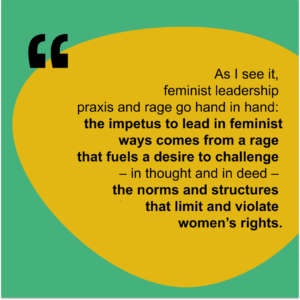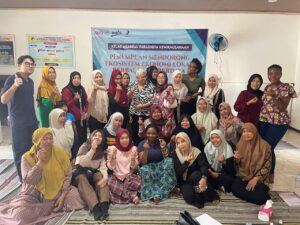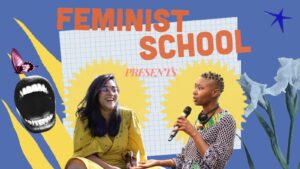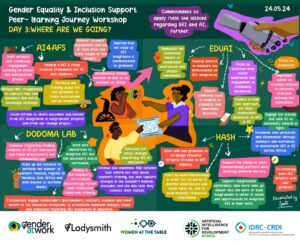Based on an interview with madeleine by Aayushi Aggarwal and Mariana Silverio
Meet madeleine kennedy-macfoy, Gender at Work’s new executive director.
After a decade of leading work on women’s rights & gender equality at Education International, the global federation of teachers’ trade unions, madeleine kennedy-macfoy is joining our team as our new fearless feminist leader.
madeleine started working on women’s rights as a program officer for Amanitare, the first African feminist network on sexual and reproductive health and rights, and has since then navigated the seas of academic research, policy & advocacy, international organizations, and global partnerships. Read her complete bio here.
What excites you most about taking on this role with Gender at Work?
What excites me about Gender at Work is the fact that we are loud and proud about our feminism! I’m excited about working with a community of people who are all about equity and justice in institutions and organisations, and just generally in the world; a community of people who don’t need convincing that radical transformations are absolutely critical to the survival of the planet and of the most vulnerable ad marginalised people.
What aspects of your personal journey brought you to this specific point in your work life?
I guess the genesis of my commitment to women’s rights was my experience of being a little girl, growing up in a household with a younger brother. I vividly recall when – around the age of 9 or 10 ten – my mother started teaching me how to cook (like most west/African mothers of her generation did with their daughters). My mum said that whenever she was in the kitchen, I had to be there with her, to learn. My favourite pass time at that age (and still today!) was reading. So, I would have to put down whatever book I was reading to go and be in the kitchen. I noticed right away that I was the only one being told to do this; my brother could continue playing with toys– he didn’t have to go into the kitchen (even when he grew older). Oh, this made me so angry! Of course, at the time, I couldn’t express or even articulate this rage, but I felt it. I felt it very strongly. I was enraged because I thought this was unjust; unfair. Looking back, I think that was like a kind of awakening or a realisation of what it felt like to be treated unequally. I really, really didn’t like it!
Injustice still never fails to enrage me. I think that’s what led me to make the choices I made about the direction that my studies and professional journey would take. What has remained unchanged within me – starting from when I was a pre-pubescent little girl – is an unwavering sense that injustices must always be resisted. I couldn’t do anything about it when I was 9 or ten years old, but as soon as I could, I set myself on a trajectory that would allow me to learn more about how to recognise, undo, prevent and redress injustice. I feel like all of that aligns with what Gender at Work is all about: looking closely at the deep structures that maintain injustice and discrimination so strongly and stubbornly in place.

How do you turn the rage you’re talking about into something you can ‘work with’ and how do you think about it in relation to feminist leadership? How do you turn that rage into feminist change that is constructive and positive, disruptive if it need be, but more thoughtful?
It was such a huge relief to read the work of bell hooks and Audre Lorde! To see articulated, so poetically and powerfully, all that I had been feeling and thinking, but did not have a language to name. I learned (and am still learning) from hooks and Lorde and from many other Africa diaspora and African women writers, academics and activists that I definitely could and should ‘work with’ my rage. It’s a source of energetic power that keeps me alert and attentive, even as I continue to learn about how to tap into it in constructive and strategic ways. My always already learning question is: ‘What will it take to for me to use my rage against injustice to contribute constructively to positive transformative change in this world?’ I think many people would agree with one emerging answer to that question: be the change I want to see (yes, so cliche, I know it!). To transform myself, to continuously be unlearning harmful ways of being an individual, which contribute to collectively harmful ways of being human. So, as I see it, feminist leadership praxis and rage go hand in hand: the impetus to lead in feminist ways comes from a rage that fuels a desire to challenge – in thought and in deed – the norms and structures that limit and violate women’s rights.
What kind of work have you been doing over last few years and how does it relate to joining Gender at Work?
My previous role was at Education International (EI), the Global Union Federation that is the voice of education workers worldwide. It was a fascinating vantage point from which to think about and work towards increasing women’s participation and leadership. Globally, the education sector is dominated by women workers, but proportionally speaking, fewer women are in decision-making and leadership positions compared to their numbers as workers in the sector. So key questions that I was grappling with at EI are what does it take to get women into leadership? What does it take to sustain women’s leadership? These are questions I know Gender at Work has also been preoccupied with and developing tools to address. Trade unions are notoriously hierarchical organisations with power constantly shifting and changing within them. I’ve been observing and learning a lot about how to navigate power in that kind of environment over the last decade. So, the focus on, and analysis of different forms of power – particularly within organisations – by Gender at Work strongly aligns with what I’ve been focusing on in my work in my immediate past professional life. Joining Gender at Work right now feels like a serendipitous match made in feminist heaven!
You have already tapped into our next question by mentioning that you’re bringing your passion for learning, your rage, care, love, and empathy to the table. So when it comes to what you’re bringing to this role, is there anything else you would like to add in terms of your own perspective(s) and passions?
Yes! I love the creative dimension of humanity, of what it means to be human. It is central to everything. I love music, I love to dance, I love poetry, I love literature. I see that integrating these possibilities is already there in the way that Gender at Work does work. So I’m excited that I can bring my whole self, including my creative, fun, loving, joyful self, into my work. Gender at Work feels like somewhere I can fully be who I am…(becoming).
–
Mariana Silverio is the Communications Coordinator at Gender at Work, and Aayushi Aggarwal is the communications manager at Gender at Work.
Sign up for our newsletter and stay up-to-date with notifications about our new blog pieces.
[contact-form-7 id=”25436″ title=”Subscribe (Blog)”]



